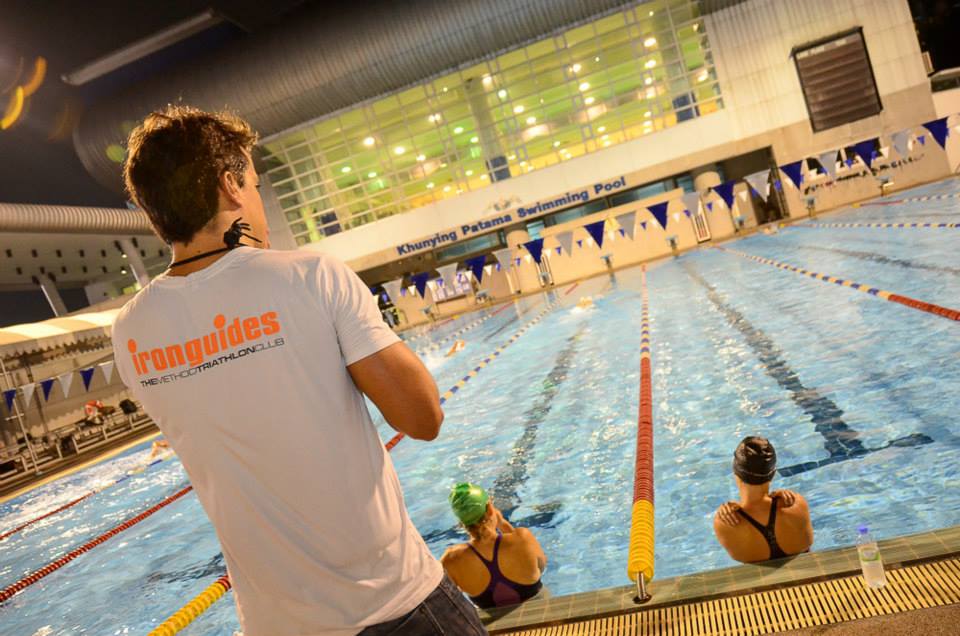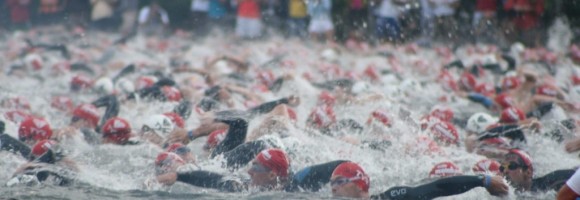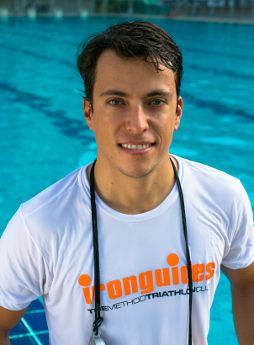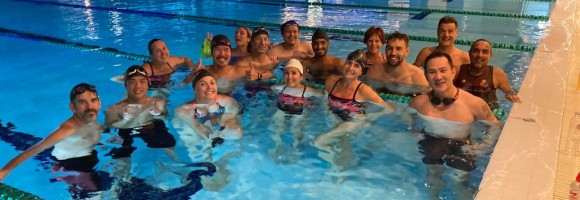I was approached by one of our athletes after our swim training one night and he asked why we don’t technique work and kicking sets. While I welcome pure swimmers to my squad as an opportunity for them to get fit, these swimmers can be very experienced, and this day, this athlete suggested the rest of our group would improve if we spent part of the session working on technique drills rather than fitness.
Coming from a swimming background, more specifically a breakstroker and sprinter, which is a combination that weighs heavily on technique rather than fitness, he just couldn’t relate to the challenges that most of our swimmers, as triathletes, need to deal with when it comes to the specifics of triathlon swimming.
I had to remind him that our group is a triathlon group and that’s why we do things differently to the traditional swimming master programme. The article below should clarify the main points, and where your focus should be.

ironguides Triathlon Squad in Bangkok, Thailand
1) Technique is individual
1.1 Background
At our squad we have athletes who have swam at the Swimming Olympic Trials to a first timer that can barely make it across the pool, and all levels in between. To prescribe one same drill to both athletes would be a waste of time and effort, since their needs are completely different, the experienced swimmer may need to work on specific open water skills or adjust the swim stroke to more sufficient style since the training load is lower than it used to be at peak shape and that impacts the technique used.
The beginner needs to go back to the basics, learn timing of breathing, basic balance work in the water and just develop a better feel and confidence for the water.
As we use a 8 lane pool with roughly 3 swimmers per lane, and prescribing specifics sets to each individual is just impossible. For that reason, I prefer to have our swimmers working on a 1-on-1 when it comes to technique, the coach can focus solely on that athlete, their needs and goals.
1.2 Body type affects technique
On a similar note to the background of each swimmer, the body type also has a huge impact on how you should use your swim stroke.
While the smooth and long glide swimming style is easy on the eyes and may work for a very specific type of swimmer that tend to do very well in high performance swimming, its definitely not the most appropriate style for most swimmers.
To hold a long stroke, one needs a powerful kick to avoid any momentum loss, otherwise the stroke becomes an “accelerate, decelerate, accelerate, decelerate” type of movement and that is certainly no the most efficient way to swim.
Then we have the main component in the swim kick which is ankle flexibility. Triathletes, especially men, tend to have very pool ankle flexibility due to all the running and cycling, ankles and lower leg muscles are chronically tight which makes kicking almost impossible, in fact most triathletes couldn’t kick across the pool without getting to the other side in total exhaustion.
Another challenge with aiming to build a better swim kick is how much energy, or leg muscle glycogen that work will take that could be better used when cycling or when running. On race day, muscle glycogen is your primary source of energy and applying a strong kick for the entire swim length will only lower the amount of energy left for the bike and run
1.3 Pool VS Open Water – different environments
Going back to the stroke types, we have your typical ‘glider’ that suits a tall male athlete with a strong kick, and the second option is a short and choppier stroke with a very fast turnover rate, that is the recommended stroke for most triathletes and also used by some pool swimmers, especially shorter athletes doing long distance events. The difference comes from the environment you are swimming at. Quoting my colleague Alun Woodward (ironguides UK) on his article published by Triathlete Magazine:
“First let’s start by understanding that “open water swimming” is not about extending the lane in your pool into an empty, 1500-meter long, flat water course with a lane rope on each side (as some swim instructors have recently suggested). Instead, open water swimming as experienced by the vast majority of Age Group swimmers is a churning, rough-and-tumble experience in which all the rules of pool swimming are broken! How long have you been able to hold a delicate, careful, well thought out stroke in a race?
That’s right – about 10 seconds! With every stroke there seems to be something to impede your progress and stall you in the water: Chop from the wind, other swimmers’ elbows, someone pulling on you or swimming overtop of you, ocean swell, murky water, air bubble froth, feet impeding your ability to catch water, and so on. It’s like swimming in a washing machine and needing to re-accelerate with every stroke! Because of this constant interference and challenge at every stroke, the truth about triathlon swimming is that to improve your abilities in the open water you need to do almost the opposite of what you did to develop swim technique in the pool!”

Choppywaters, wind, ‘White caps’, sighting, drafting, wetsuit, makes triathlon swimming very unique
2) Cycling, Running training and its impact on swimming training
Lets start with the fact that triathletes are fatigued all the time from the accumulate training they do. Very often we have some athletes who cycled or ran in the morning of our evening swim session. Their legs are still fatigued, maybe sore and with less than ideal glycogen stores. One can’t expect a strong swim kick out of this combination.
This connects to my favourites training gear in the pool. The pullbuoy, paddles (and ankle bands for very experienced swimmers). They can be used separately or in different variations according to the goal of the session and level of swimmer.
The main benefit of the paddles+pullbuoy is to provide a little help to the swimmer, the pullbuoy will give the swimmer a lift, taking the struggle out of swimming, then one can focus on the workout intensity and other technique details.
The hand paddle will lower the swimmer heart rate while increasing the muscle load, this results in the swimmer being able to train very hard even on a fatigue state from a morning run or ride. The swimming arms will take all the work.
You may ask if this isn’t “cheating” and that on race day triathletes can’t swim with paddles or pullbuoys, then we need to think about the race day circumstances. First, most swims are done in the ocean and due to the different density of salty water to the pool, one can float a lot more and that simulates the same lift from the pullbuoy. So not only using a pullbuoy will help you in training but it is also specific to ocean swims.
The other factor is that fatigue levels on race day will be inexistent unlike in training, any experienced athlete will freshen up some before a race and that will allow him to swim faster and with a better technique than what this same athlete would be able to do in training conditions.
And finally, a lot of races, especially in North America, Australia and Europe, are wetsuit legal swims. And anyone who has swam in a wetsuit knows how much extra lift that provides you and also the extra stress on the shoulders. So other than swimming in a pool in your wetsuit, another way to train specifically for it is to use pullbuoy+paddles for a large part of your swim sessions.
3) Swimming as part of cycling or run training
3.1 Allocating your training hours to swim fitness
Looking into a weekly training plan of a typical age group triathlete, we would see 2-3 swims per week along with 2-3 bikes for a total of 6 to 9 weekly sessions, to make it simple, lets say that our athlete is spending 2h30 (2x 75min sessions) in the pool every week, and is training for a Half Ironman Distance event, where the swim is 1.9km and will take around 30 minutes, those are average numbers to a working age grouper with family and other commitments outside of training.
Which training programme do you think would get you not only faster to transition one, but also fresher for the bike and run:
Option 1: Traditional Pure Swimmers programme, 50% of Main set/Fitness work (1h15 focused on specific fitness)
Option 2: Triathlon Swimming programme, 100% of Main set/Fitness work (2h30 focused on specific fitness)
3.2 Balancing your swimming training with cycling and run training
The next step that impacts your swim session is the type of work you did before that swim session on the bike and run, and the type of work you will be doing tomorrow.
ironguides training approach is based on hormonal balance, and the reason why our swim session is on Monday, and is focused on speed and strength, isn’t a coincidence. After a long weekend on the bike and run, usually the only available time for age groupers to go long, the endurance stimulus that you got from the weekend will trigger a catabolic hormonal reaction on your system, and Monday’s session mitigates that process by triggering anabolic stimulus such as increasing growth hormone and testosterone levels. You know those all out sprints with hand paddles? They aren’t much different than lifting in the gym, but specific to your sport.
This not only allows you to train hard, but also is healthier as avoids the typical ‘aerobic breakdown’ that most triathletes deals with.
We like to say that triathlon is swimbikerun and not swim+bike+run, both in training and race day all disciplines are connected. Your swim training of today is planned based on your cycling training of yesterday and the run training of tomorrow
4) Swim fitness impact on bike run on race day
Now that we’ve discussed the training differences of a pool swimmer and a triathlete, we also need to look into the race day requirements
We saw that triathlon is swimbikerun and not swim+bike+run, or in other words, your swim fitness on race day will have an impact on your bike and run splits.
If you are walking the last third of your ironman marathon for example, the culprit could be in your swim fitness. The fatigue only accumulates during the day and it may ‘pop’ on the run especially if combined with other poor race day decisions related to nutrition and pacing.
One very typical scenario is the experienced swimmer who thinks he can get away with very limited swim training over the long course races, while this swimmer may still be able to finish the swim at a decent split, is very likely he will pay a high price later in the race. One thing is to be fast, another is to be fit, and fitness is everything when it comes to triathlon.
I hope the above article clarifies the difference of pool swimming training VS triathlon swimming training and help you to focus your efforts on what works. Make sure the swim program you are following understand the needs of triathlon swimming.
Happy laps,
Vinnie Santana, ironguides Head Coach
ironguides is the leading Lifestyle Facilitation company for athletes of all abilities. We provide coaching and training services, plans and programs, as well training education, health and fitness products to help you learn and live a healthy lifestyle. Come get fit with one of our monthly training subscriptions, event-specific training plans, coaching services, or a triathlon training camp in an exotic location! ironguides also provides Corporate Health services including Corporate Triathlons, Healthy Living retreats and speaking engagements. At ironguides, your best is our business!
Train with ironguides!
Personalized Online Coaching: Starting at USD190/month
Monthly Training plans (for all levels, or focused on one discipline): Only USD39/months
Event based training plans:
Sprint Distance (USD45 for 8-week plan)
Olympic Distance (USD65 for 12 week plan)
Half Ironman (R$95 for 16-week plan)
Ironman (USD145 for 20-week plan)
X-Terra (USD65 for 12-week plan)
Running Plans (10k, 21k and 42k – starting at USD40)





















Recent Comments